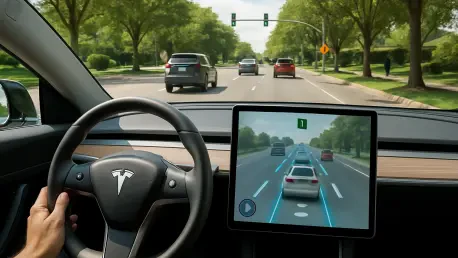I’m thrilled to sit down with Vijay Raina, a renowned expert in enterprise SaaS technology and software design, whose thought leadership in architecture and innovation offers unique insights into the evolving world of automotive tech. Today, we’re diving into the hot topic of Tesla’s Full Self-Driving (FSD) system, as Senators Markey and Blumenthal push for a safety review over concerns at railroad crossings. We’ll explore the specific risks highlighted, regulatory actions being urged, public perception of autonomous driving, and the broader implications for the industry.
Can you walk us through the main reasons Senators Markey and Blumenthal are calling for a safety review of Tesla’s Full Self-Driving system?
Certainly. The senators are deeply concerned about reports that Tesla’s FSD system struggles to detect and respond appropriately to railroad crossings. This isn’t just a minor glitch; they believe it poses a severe risk because of the potential for catastrophic collisions with trains, which could result in multiple fatalities. Unlike other driving errors, such as missing a stop sign, the stakes at train crossings are incredibly high due to the sheer force and size of trains.
What makes the risk of FSD failures at railroad crossings so much more dangerous compared to other driving mistakes?
The senators point out that a collision with a train often leads to devastating outcomes, not just for the car’s occupants but potentially for train passengers and rail workers as well. Unlike, say, running a red light or an improper lane change, which might result in fender benders or limited injuries, a train-car crash can be a multi-fatality event. The sheer scale of destruction in these scenarios elevates the urgency of addressing FSD’s shortcomings in such critical situations.
What specific steps are the senators asking the National Highway Traffic Safety Administration to take regarding Tesla’s FSD system?
They’re pushing for NHTSA to step in with restrictions on how and where FSD can be used, ensuring it’s not deployed in high-risk scenarios like railroad crossings until proven safe. Additionally, they want Tesla to rename the system, arguing that “Full Self-Driving” misleads consumers into overestimating its capabilities. Their goal isn’t a total ban but rather targeted limits and clearer communication to prevent misuse.
How would you describe the public and regulatory response to Tesla’s autonomous systems like Autopilot and FSD over the years?
There’s been a mix of fascination and skepticism. The public is intrigued by the promise of self-driving tech, but high-profile incidents have fueled distrust. Regulators, on the other hand, have been increasingly critical. Tesla recently settled lawsuits tied to Autopilot, showing legal pressure is mounting. Meanwhile, NHTSA’s ongoing probes into FSD reflect a broader concern that the technology might not be ready for widespread use, especially under challenging conditions.
Can you shed some light on the recent NHTSA investigation into Tesla’s FSD system that started in October 2024?
Absolutely. NHTSA launched an investigation into about 2.4 million Tesla vehicles equipped with FSD after multiple collision reports surfaced, including a tragic fatal incident. A key factor in these crashes seems to be reduced roadway visibility, which likely hampers the system’s ability to detect obstacles or hazards. This probe underscores the need for robust testing in less-than-ideal conditions, something autonomous systems must master to be truly reliable.
Why do the senators argue that the name “Full Self-Driving” could be misleading to consumers?
They believe the term suggests a level of autonomy that the system doesn’t actually have. It implies the car can drive itself completely without human intervention, which isn’t the case—drivers still need to stay alert and ready to take over. This mismatch between name and reality can lead to overconfidence, potentially causing dangerous situations where users rely too heavily on the tech.
How do safety concerns like these impact the broader trust in autonomous driving technology as a whole?
These issues can significantly erode public confidence. When high-profile cases like Tesla’s FSD failures make headlines, especially with fatal outcomes, it creates a ripple effect. People start questioning not just Tesla but the entire concept of self-driving cars. It slows adoption, as potential users worry about safety, and it puts pressure on the industry to prioritize transparency and rigorous safety standards over rapid deployment.
What’s your forecast for the future of autonomous driving technology in light of these challenges?
I think we’re at a critical juncture. The technology has immense potential to transform transportation, improving safety and efficiency in the long run. However, incidents like these highlight that we’re not there yet. My forecast is that we’ll see stricter regulations and more collaborative efforts between automakers and regulators to set clear safety benchmarks. For autonomous driving to succeed, rebuilding public trust through proven reliability will be key, and that might mean slowing down deployment to focus on getting it right.









